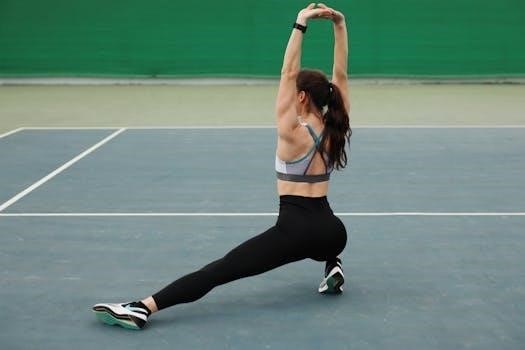Printable Rotator Cuff Exercises PDF⁚ A Comprehensive Guide
Are you seeking a structured approach to shoulder rehabilitation? Our comprehensive PDF provides a curated selection of rotator cuff exercises. Download and print for easy access to your personalized strengthening program.
Understanding Rotator Cuff Injuries
The rotator cuff, a group of muscles and tendons, stabilizes the shoulder, enabling a wide range of motion. Injuries commonly arise from overuse or trauma, impacting individuals aged 40-70.
Tendonitis, bursitis, and tears are frequent issues. Pain and weakness during arm movements, especially overhead activities, are telltale signs. Recognizing these symptoms early is crucial for effective intervention.
Rotator cuff pain involves discomfort and inflammation in the shoulder joint’s surrounding muscles and tendons. Understanding the root cause—be it a traumatic event or chronic overuse—is essential. Addressing postural imbalances and avoiding exercises that exacerbate pain can aid recovery.
The deltoid muscle plays a supporting role to the rotator cuff; strengthening it can alleviate pain and enhance range of motion. Early diagnosis and appropriate exercises are vital for managing rotator cuff injuries and restoring shoulder function.
Benefits of Rotator Cuff Exercises
Rotator cuff exercises offer numerous advantages, particularly in recovery from injury or surgery. These exercises strengthen the muscles supporting the shoulder joint, enhancing stability and reducing pain. Improved range of motion is a key benefit, allowing for greater functionality in daily activities and recreational pursuits.
Regular exercise can also correct postural imbalances, preventing further strain on the shoulder. By targeting specific muscles, these exercises ensure balanced shoulder mechanics, reducing the risk of re-injury.
Furthermore, structured exercise programs have demonstrated a positive correlation with rotator cuff tendinitis relief. Rehabilitation exercises restore function and promote long-term shoulder health.
Exercises aid in gradually increasing tendon loading, improving the tendon’s structural integrity and functional capacity. Always adhere to proper form and technique to maximize benefits and minimize risk of aggravation.
With consistent exercise, individuals can return to daily activities with renewed confidence and comfort.
Types of Rotator Cuff Exercises
Rotator cuff exercises encompass a variety of techniques designed to restore function and strength. Range of motion exercises, such as pendulum swings and wall climbing, improve flexibility and reduce stiffness. Strengthening exercises, including isometric, theraband, and dumbbell routines, target specific muscles for enhanced support.
Isometric exercises involve contracting muscles without movement, ideal for early-stage rehabilitation. Theraband exercises utilize resistance bands to gradually increase strength and endurance. Dumbbell exercises offer a progressive challenge as strength improves.
Post-surgery rehabilitation often includes passive range of motion exercises, gradually transitioning to active and resisted movements. Stretching exercises, like posterior and overhead stretches, further enhance flexibility and reduce pain.
A well-rounded program incorporates all these types, tailored to individual needs and recovery stage. Remember, consistency and proper form are crucial for optimal results and preventing re-injury. Always consult with a healthcare professional before starting any exercise program.

Range of Motion Exercises
Range of motion exercises improve shoulder flexibility and reduce stiffness. These exercises are crucial in early rehabilitation, promoting healing and preparing the shoulder for strengthening exercises.
Pendulum Swings
Pendulum swings are gentle exercises ideal for initiating shoulder mobility. They help to relieve pain and stiffness following an injury or surgery.
How to perform⁚ Begin by standing next to a table or chair for support. Lean forward slightly, allowing the affected arm to hang freely. Gently swing the arm in small circles, forward and backward, and side to side. Use your body to initiate the movement, keeping the arm relaxed. Gradually increase the size of the circles as comfort allows.
Perform this exercise for 2-3 minutes, several times a day. It is important to avoid forcing the movement and stop if you experience pain. Pendulum swings promote circulation and reduce muscle spasms, facilitating the healing process. They are a safe and effective way to regain range of motion in the shoulder.
Wall Climbing
Wall climbing is a simple yet effective exercise to improve shoulder flexion and range of motion. It helps to gradually increase the overhead reach and flexibility of the shoulder joint.
How to perform⁚ Stand facing a wall with your fingertips touching the surface at waist level. Slowly walk your fingers up the wall, gradually raising your arm as high as comfortable. Focus on using your shoulder muscles to lift your arm, rather than compensating with your back or neck. Hold the position at the highest point for a few seconds, then slowly walk your fingers back down the wall.
Repeat this exercise 10-15 times, several times a day. It is important to maintain good posture and avoid shrugging your shoulders. Wall climbing can be modified by using a towel or cloth to assist with the movement. This exercise helps to restore normal shoulder mechanics and reduce pain.

Strengthening Exercises
These exercises focus on building strength in the rotator cuff muscles. This will improve shoulder stability and function. Start slowly and gradually increase resistance as you gain strength.
Isometric Exercises
Isometric exercises are a great way to begin strengthening the rotator cuff. They involve contracting muscles without moving the joint. This can help improve muscle activation and reduce pain. These exercises are particularly useful in the early stages of rehabilitation.
To perform isometric exercises, you will need to apply resistance to the muscles around your shoulder. This can be done using a wall, a doorframe, or even your other hand. Hold the contraction for 5-10 seconds, then relax. Repeat this several times.
One example of an isometric exercise is the internal rotation press. Stand facing a closed door, and place the forearm of your affected arm against the doorframe. Gently push inward, engaging your rotator cuff muscles. Remember to maintain good posture.
Another isometric exercise is the external rotation press. Stand with your affected side to a wall, your elbow bent at 90 degrees. Gently press the back of your hand against the wall, engaging your rotator cuff muscles. Remember to breathe evenly throughout the exercise.
Theraband Exercises
Theraband exercises are an excellent way to progressively strengthen your rotator cuff muscles. Therabands provide resistance that can be easily adjusted as you get stronger. These exercises help improve both strength and endurance. They are a versatile and effective tool for rotator cuff rehabilitation.
To perform Theraband exercises, you will need a set of Therabands with varying levels of resistance. Start with a low resistance band and gradually increase the resistance as you get stronger. Remember to maintain good posture and control throughout each exercise.
One common Theraband exercise is external rotation. Secure one end of the band to a stable object, and hold the other end with your affected arm. Keep your elbow bent at 90 degrees and close to your body. Slowly rotate your arm outward, against the resistance of the band.
Another Theraband exercise is internal rotation. Secure one end of the band to a stable object, and hold the other end with your affected arm. Keep your elbow bent at 90 degrees and close to your body. Slowly rotate your arm inward, against the resistance of the band.
Dumbbell Exercises
Dumbbell exercises are a great way to build strength in your rotator cuff muscles. However, it’s crucial to start with very light weights to avoid re-injury. Proper form is paramount to isolate the rotator cuff and prevent compensatory movements from other muscle groups.
One effective dumbbell exercise is the lateral raise. Stand with your feet shoulder-width apart, holding a light dumbbell in each hand. Keeping your arms straight, slowly raise your arms out to the sides until they are parallel to the floor. Lower them slowly back down.
Another good exercise is the prone row. Lie face down on a bench, with your feet flat on the floor. Hold a light dumbbell in each hand, letting your arms hang straight down. Keeping your elbows close to your body, slowly lift the dumbbells up towards your chest.
Remember to focus on controlled movements and avoid using momentum. If you experience any pain, stop the exercise immediately. It’s best to consult with a physical therapist or healthcare professional.

Post-Surgery Rehabilitation Exercises
Post-surgery rehabilitation is a crucial phase in regaining full function after rotator cuff repair. These exercises are specifically designed to restore range of motion, strength, and stability to the shoulder joint. It’s imperative to follow your surgeon’s and physical therapist’s instructions meticulously during this stage.
Initially, the focus will be on gentle passive range of motion exercises. These involve using your other arm or a therapist to move your operated arm, preventing stiffness without stressing the healing tissues. As healing progresses, you’ll transition to active-assisted exercises, where you use your own muscles to a limited extent, supported by your other arm or a device.
Isometric exercises, which involve contracting muscles without movement, are also introduced early to activate the rotator cuff muscles without placing excessive strain on the surgical repair. Gradually, you will progress to more challenging strengthening exercises using resistance bands or light weights, as guided by your therapist.
Remember, patience and consistency are key to a successful recovery.

Important Considerations and Precautions
Prioritize safety during rotator cuff exercises. Listen to your body, avoid pain, and maintain proper form. Consult a healthcare professional before starting any new exercise program.
When to Consult a Doctor
It’s crucial to seek professional medical advice if you experience persistent shoulder pain, especially if it’s accompanied by weakness, limited range of motion, or difficulty performing daily activities. Sharp, sudden pain following an injury warrants immediate attention.
If your shoulder pain doesn’t improve with home exercises or over-the-counter pain relievers, consult a doctor. Numbness, tingling, or radiating pain down your arm are also red flags. A healthcare provider can accurately diagnose the cause of your shoulder pain and recommend the most appropriate treatment plan, potentially including physical therapy or other interventions.
Moreover, if you’ve recently undergone shoulder surgery, strictly adhere to your surgeon’s post-operative instructions and attend all scheduled follow-up appointments. Any concerning symptoms, such as increased pain, swelling, redness, or drainage from the incision site, should be promptly reported to your doctor. Timely medical intervention can prevent complications and optimize your recovery.
Proper Form and Technique
Maintaining correct form and technique is essential to maximize the benefits of rotator cuff exercises and minimize the risk of injury. Before starting any exercise program, carefully review the instructions and illustrations provided in the printable PDF. Pay close attention to the recommended posture, movement patterns, and range of motion.
Engage your core muscles to stabilize your torso and maintain proper spinal alignment. Avoid shrugging your shoulders or arching your back. Perform each exercise slowly and deliberately, focusing on controlled movements rather than speed. If you’re unsure about the correct form, consider working with a physical therapist or certified trainer who can provide personalized guidance.
Start with a low resistance level and gradually increase it as your strength improves. Listen to your body and stop if you experience any pain or discomfort. Remember, consistency and proper technique are more important than lifting heavy weights or performing a high number of repetitions. Prioritize quality over quantity to ensure a safe and effective workout.

